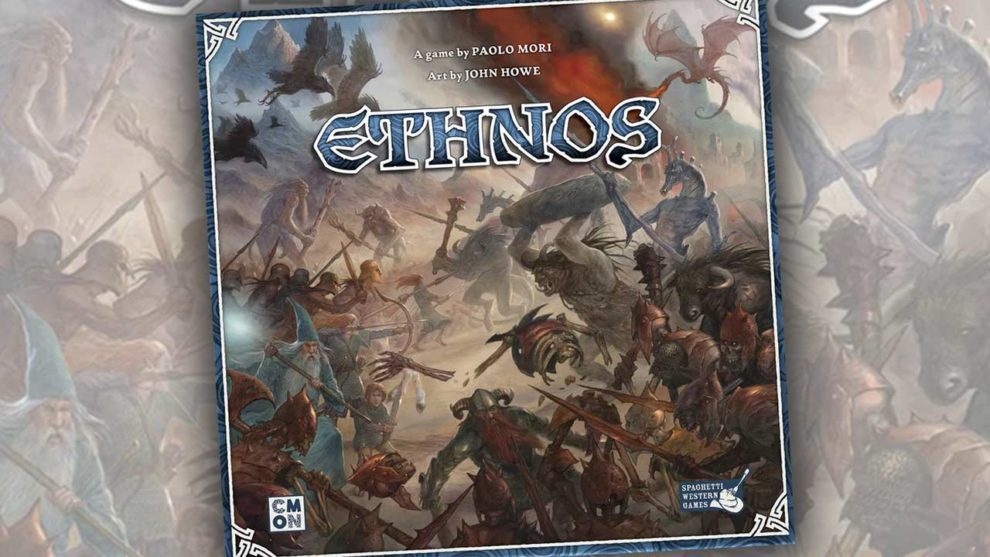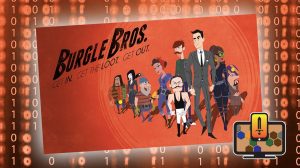Ethnos sat on my Shelf of Shame for well over a year. Review copies needing to be played and other games, more enticing games, kept it on that shelf. Recently, I decided it had sat there long enough and I took it to my weekly gaming group.
Ethnos combines set collection, hand management, and area control, with two scoring mechanics. There’s also a nice twist to the hand management aspect after playing a set of cards you’ll want to pay attention to. Depending on the number of people, the game plays out over two or three Ages. The person with the most Glory/VP at the end of the final Age wins.
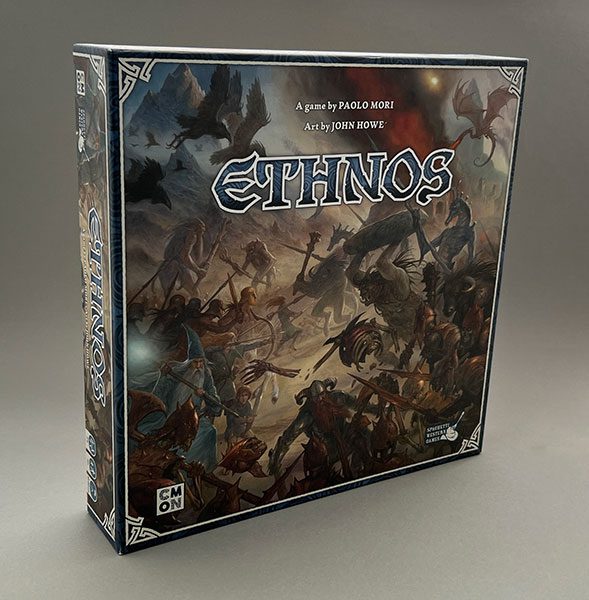
Setting Up the Game
Set out the game board within easy reach of all players. Take out the Glory tokens and, depending on the number of players, place the appropriate number of tokens in the spaces adjacent to the six Kingdoms of Ethnos.

Take the twelve setup cards and give them a good shuffle. Randomly draw six of them and place them face up. Each of the setup cards has a single Tribe on their face. You’ll now go through the Tribe decks to pull out all the cards for the six Tribes chosen for the game.
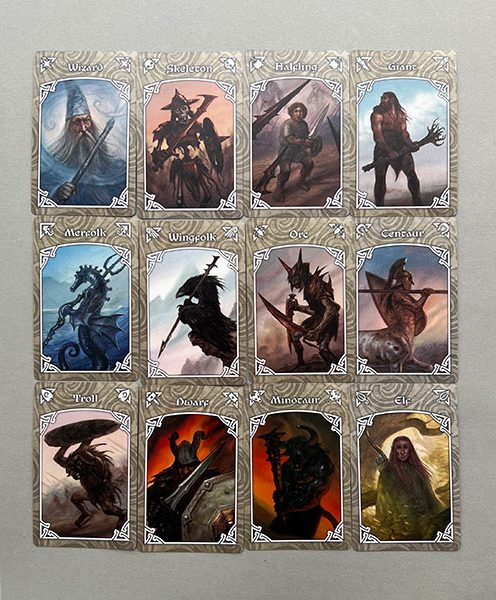
Shuffle all six Tribe decks thoroughly to create one large deck. Cut the deck in half and randomly add in each of the three Dragon cards to one half. Then shuffle that half of the deck well and place the other half of the deck on top of it.
Deal one card to each player. Then place a number of cards equal to twice the number of players face up below the bottom of the board for all to see.
And you’re ready to play.
Playing the Game
On a turn, you take one of two actions:
- Draw a card
- Play a Band of cards in front of you
When you draw a card, you can choose to either draw blindly from the deck or you can choose one of the face up cards (if there are any) to add to your hand. Cards drawn from the face-up cards are not immediately replaced. (More on this later.)
Throughout the game, you’ll have a hand limit of 10 cards. If you start your turn with 10 cards you must Play a Band of cards on that turn.
Playing Bands of Cards
When drawing cards, you’re trying to collect one of two types of matching sets, or Bands, as the game calls them. You’re either looking to collect matching Tribe members (Dwarves, Elves, Wizards, etc.) or cards from the same Kingdom (Althea, Rhea, Straton), as indicated by their colored border.

Playing Bands does two things: they help gain control of the Kingdoms, and they score you End of Age points. An understanding of these two is crucial to how well you’ll play Ethnos.
When you play a Band, regardless whether it’s a Band of a single Tribe or if the different Tribe members all share the same Kingdom border, you’ll choose one of those Tribe members to place on top. This card serves as the Band Leader.
If your Band comprises a single Tribe, the borders of the cards will be different. Choosing the Band Leader means you’re choosing the Kingdom you may place one of your Control tokens into, based on that Kingdom’s color.
If the Band is made up of different Tribes all from the same Kingdom—that is, they all share the same colored border—you’ll choose a Leader based on that Tribe’s special powers.
In either case, after the Band has been played, follow the special powers listed at the bottom of the Leader’s card. Each Tribe has its own power, so you’ll need to decide carefully.
The Rest of Your Hand
What about the rest of your hand after you’ve played a Band? Wouldn’t it be great if you could keep building on the cards you already have? Well, sure—but that would be too easy. In what I think is a great twist, the remaining cards in your hand are each placed face-up in the supply of available cards at the bottom of the board.
This makes deciding when to play a Band that much tighter of a decision. Do you keep pushing your luck, hoping for one more of the Band you’re hoping to play? Or do you not want to take the chance of giving your opponents even more cards from your hand?
Placing Control Tokens
It’s important to note you can only place a Control token in a Kingdom if the number of cards in your Band is greater than the number of Control tokens in that Kingdom. When you start the game, you’ll be able to place a Control token on any Kingdom matching the Band you just played because you don’t have any tokens on the board.
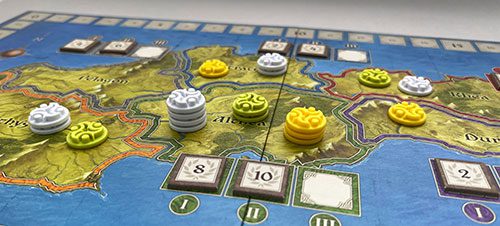
The player with the most Control tokens in a Kingdom will be awarded points based on the Glory tokens on the border of that Kingdom. Some are modest, while others go to eleven, er, ten. And ten points is a lot in this game.
The game continues until the third Dragon card is revealed in the deck. At that point, the game immediately ceases and End of Age scoring begins. If it’s the end of the First Age, leave the Control tokens on the board and collect all the cards. Shuffle well and add the three Dragons as described above and carry on into the Second (and Third, if playing with 4+ players) Age.
Scoring
Speaking of scoring, couldn’t you play a Band of one and place your first Control token on the chosen Kingdom to get on the board? Well, yes, but there are better choices.
The size of your Band matters in End of Age scoring. And while the Glory tokens do represent additional End of Age Glory, the majority of your points are going to come from the size of the Bands you play throughout an Age.
Take a look at this chart:
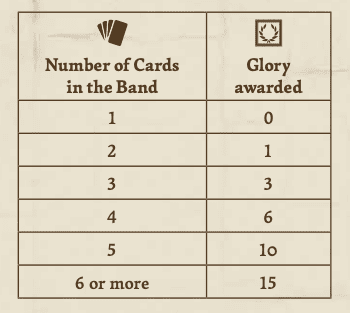
But Wait…There’s More!
Most of the Tribes each have straightforward powers and use the standard scoring.
There are five Tribes that work a bit differently.
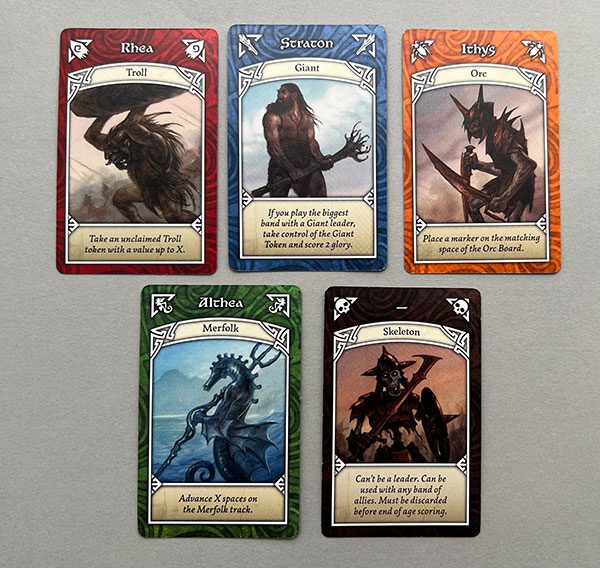
Of the five, the Skeletons are the easiest to explain. They cannot be Leaders, and are only good for Control count. Once the Age ends, the Skeletons dissolve to dust and do not count for Band size scoring.
Each of the other four come with additional items.
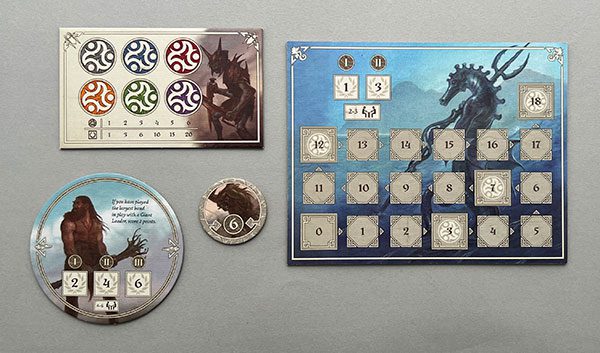
The Orcs have an additional scoring board based on the Kingdom color of the Orc leader you play. Similarly, the Merfolk have their own scoring board, one that allows you to place a Control token on the Kingdom of your choice. If you play a Troll as a Leader, you claim Troll tokens which break Control ties in the Kingdoms. The first player to play a Band with a Giant Leader gets the giant Giant token and immediately gains two Glory. Whoever holds the Giant token at the end of an Age gains additional Glory.
Thoughts
Ethnos was an easy game to learn and an easy game to teach. The rules have a few twists, but they’re interesting ones and certainly not confusing.
The setup takes a bit longer than some games due to getting all the Tribes shuffled together and then adding the three Dragons to the bottom half of the deck. That time will be more than made up for with the speed at which Ethnos plays. In my three-player games, we frequently would hardly have time to look at the card we just drew before it was our turn again.
That’s not to say Ethnos is a simple game. It’s a light-to-medium weight game that just moves quickly. You’ll pause over your cards from time to time, weighing your choices, largely thanks to having to surrender all your unused cards after playing a Band. It can be difficult to give up that many cards—and even harder to watch as they’re grabbed up quickly by your opponents.
That mechanic also gives Ethnos a quiet, but important level of player interaction. If it were not for that, Ethnos could easily feel like yet another multiplayer solitaire game. Knowing that playing the best Band in my hand means I have to turn over Tribe cards I know someone else is collecting gives the game an admirable, sharp edge.
A Brief Note About the Artwork
It’s not hard to find gamers online complaining about Ethnos. The board art is dull. The Tribes are generic and too dark. The Control markers don’t fit with the rest of the board.
Well, I agree with the last comment. The pastel Control tokens don’t with either the darkly drawn Tribes or the darker, more vivid colors of the Kingdom borders. That aside, I really don’t have a problem with any of the artwork. For me, it works well and fits the theme. I’ve played games with really dismal artwork, but Ethnos is not one of them.
Closing Thoughts
Ethnos was a big hit with my gaming group—one of those games that elicited a unanimous, “Let’s play that again” as soon as the first game ended. We did so, using three different Tribes and the strategies behind playing were significantly different. We would have played it a third time if we’d only had time.
Ethnos was released in 2017 and, to date, there has only been a single promo expansion for the game. For me, this is a shame because, much like Smallworld, the Tribes of Ethnos could and should be expanded upon. (However, since Ethnos is being reimplemented by Archeos Society, that may not happen.)
It’s great to play a game that’s such a hit with my group. I think it might be a hit with yours as well.


